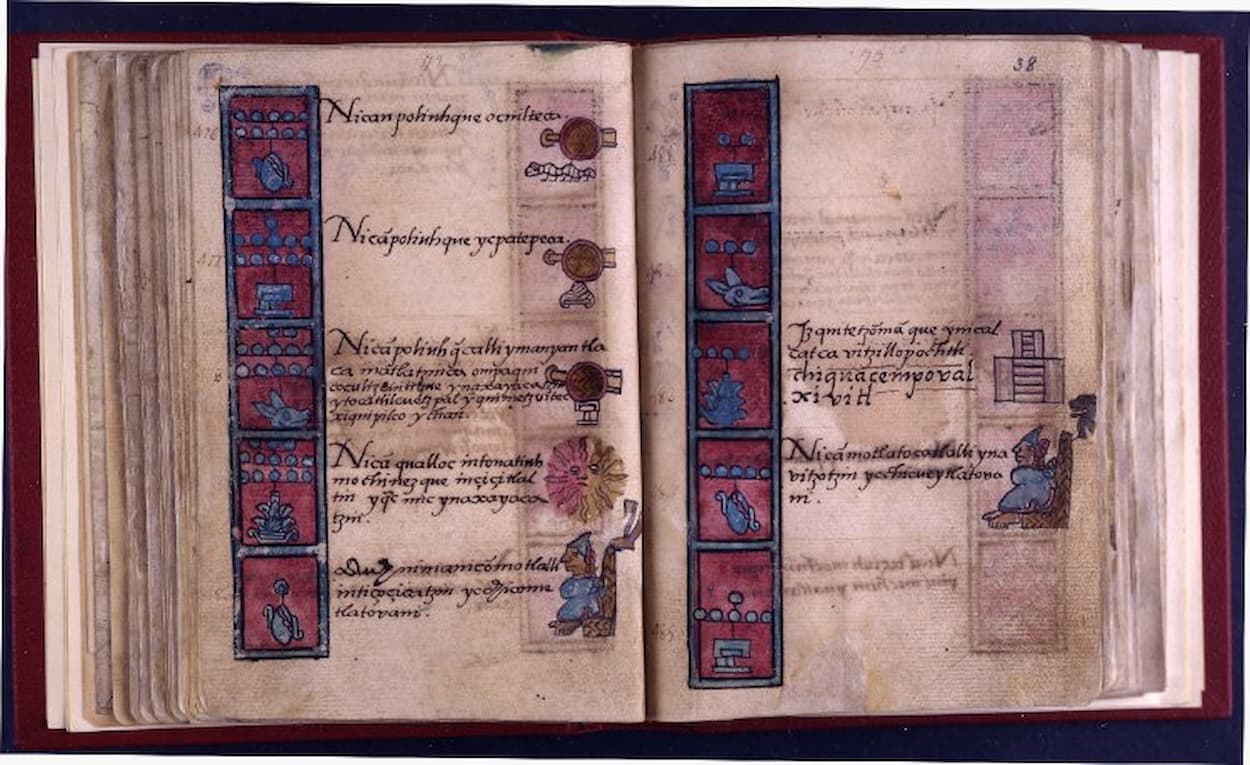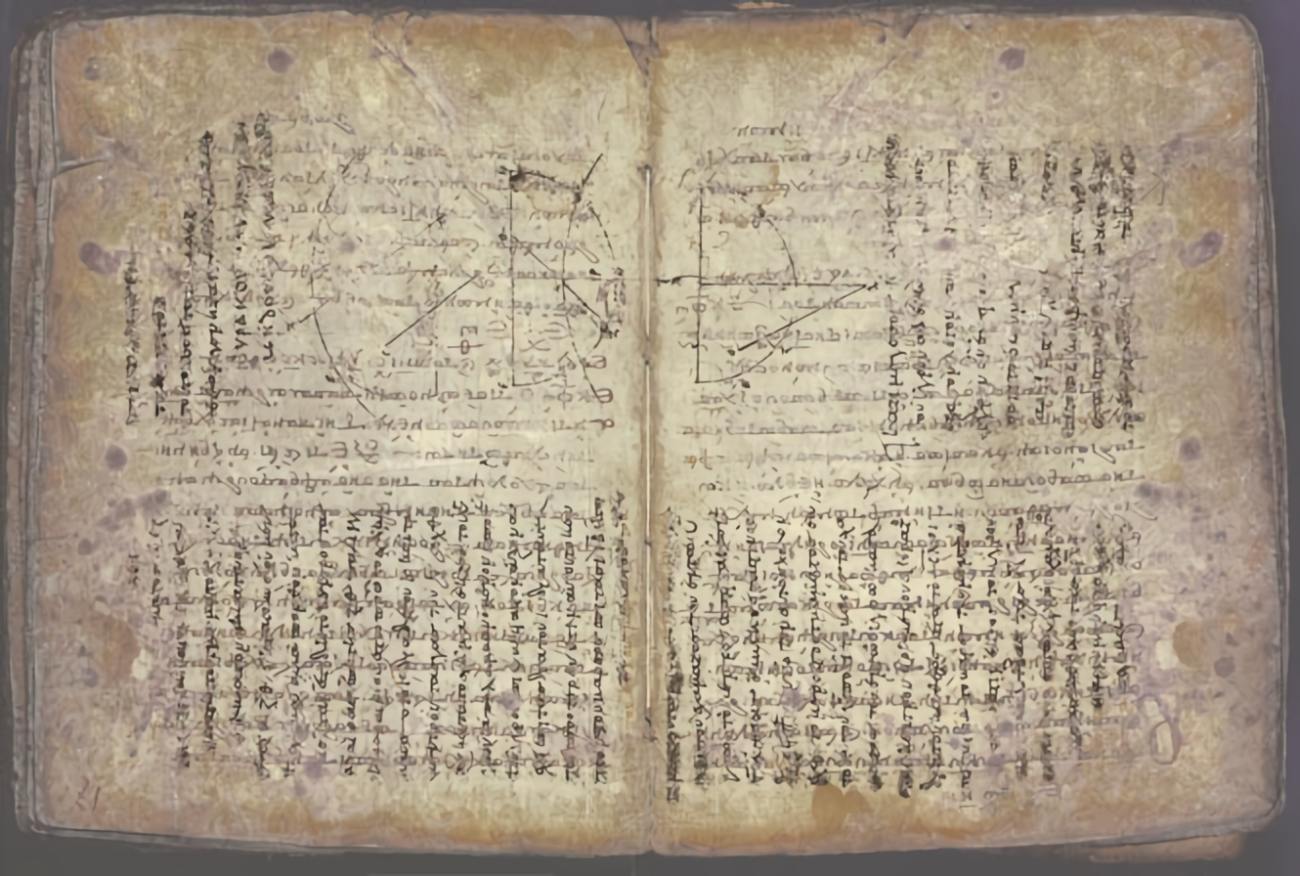The Aubin Codex, or the 1576 manuscript, is a pictorial work that recounts the Spanish version of the history of the Mexica people, narrating their migration from Aztlán in the 12th century to the Spanish conquest in the 16th century. Throughout its 81 folios or pages, the Aubin Codex records the travels of the Aztec people, including migration, the founding of Tenochtitlán, agricultural cycles, the lineage of kings, eclipses, the arrival of the Spaniards, and other significant events in the history of the Mexicas. It is a mixed codex that contains illustrated images and text written in Nahuatl with the Latin alphabet. The Aubin Codex is one of the few codices that has been transcribed and translated into more than one language.
History of the Codex
It is not precisely known who wrote the Aubin Codex, but it was likely written by various Mexican scribes and painters, known as tlacuilos, over many years. Some historians believe it was written by a compiler of pre-Columbian documents and annals. This iconographic writing system, in which the tlacuilo “inscribes on a support using a brush and ink,” developed and was perfected during the post-classic period in central Mexico.
The Aubin Codex covers the history of Mexico between 1168-1607. At the beginning of the work, it states “written here today in Mexico on the 27th of September 1576,” although it documents history until 1607. The text gets its name, “Aubin Codex,” from Mr. Joseph Marius Alexis Aubin, who purchased the document for his collection of Aztec works. Mr. Aubin lived in Mexico for fifteen years, from 1825, during which he engaged in the study of the Nahuatl language and the ancient civilizations of the region. During this time, Mr. Aubin obtained the codex prepared by the historian-collector Antonio de León y Gama. Joseph Aubin sold it in 1889 to Mr. M.E. Eugene Goupil.
It is likely that Friar Diego Durán supervised the preparation of the codex in the 16th century, as he mentions it in his “History of the Indies of New Spain and Islands of Tierra Firme.” According to historian Alfredo Chavero, who prepares the modern edition of Father Durán’s work, Mr. Aubin was “Intelligent and interested in antiquities, he befriended the Franciscan friars and was able to examine their magnificent library: in it, he found hieroglyphics and manuscripts that the ignorant friars had no qualms about ceding to him.”
Now, the original copy of the Aubin Codex is located in the British Museum in London. There is a copy in the National Library of France, a copy by Antonio Peñafiel in Berlin, and another copy in the library of Princeton University in the collection of Robert Garrett. The Aubin Codex should not be confused with the Tonalámatl Aubin, another work from the Aubin collection.
Organization
The codex consists of 81 folios, each measuring 11 x 15 cm. The codex is read from left to right and from top to bottom, following the customary norms of pre-Columbian codices in America. The codex is the result of the combination of other documents that originally formed independent codices, with its major influence derived from the “Group of the Strip” (according to Castañeda de la Paz), linking it to the Boturini Codex. In our codex, we can identify the following sections:
- 1) A brief description of the year-counting system; not present in other manuscripts of the group.
- 2) The migration from Aztlán to the defeat at Chapoltepec (1299) and their subsequent establishment in Colhuacan, a narrative almost identical to the Boturini Codex.
- 3) The final stage of their wanderings around Lake Texcoco until the foundation of Tenochtitlán.
- 4) Historical annals from the rule of Acamapichtli to Moteuczoma; closely resembling other pictorial versions such as the Telleriano-Remensis Codex or written ones like in the “History of the Mexicans by their paintings.”
- 5) The last section is the Spanish conquest of Mexico, narrating relevant events until 1576, with additional data added up to 1591 and others in 1607.
Compared to other Aztec codices, the Aubin Codex is distinctive in its organization. It is a unidirectional codex with a continuous count of years, presented as a timeline. This mechanism effectively controls the order in which the codex is read, as time follows a chronological order throughout the document. The year count is interrupted only to allow the painter to elaborate on a significant event. The imperial years in the Aubin Codex, as painted on European folios, are organized as strips, reflecting the influence of the European style.
The second part of the Aubin Codex is a collective history of migration. This style of grouping and collectivity shows the Aztec painters’ desire to organize visual space efficiently. The fourth part of the Aubin Codex can also be considered an imperial history, which, in terms of style, returns to the standard structure of the record.
The size of the images is used to communicate the importance of the main events of history, as events of equal importance are of the same size. Conversely, a less important event is depicted as smaller. In many cases, there are a series of images side by side, indicating that all the events share the same historical and cultural significance.
Content
The work focuses on the events that the people experienced from their departure from Aztlán, from 1168 to 1607, after the arrival of the Spaniards. It represents important information from various years during this time. The first page shows the Aztec calendar in square form, similar to how it appears in Durán or Tovar.
Folio 1-2 – The first folio of the codex contains Nahuatl text about Mexica’s calendrical system. Translated into Spanish, it says: “Here is written the account of the years of the Mexicas. It is made up of only four pieces that go as follows: the year 1-Acatl ends in 13-Acatl; 1-Técpatl ends in 13-Técpatl; 1-Calli ends in 13-Calli, and 1-Tochtli ends in 13-Tochtli. And when the four parts have come to an end, after 52 years, our years are tied to the year 2 Acatl. This was written in Mexico on the 27th day of the month of September 1576.”
The Mexica calendrical system was divided into four sections, each with thirteen numerals and four bearers. The bearers are reeds, flint, house, and rabbit, which are represented again in the center, next to the Sun. The bearers “were framed by the symbol of the year, usually a square, a diamond, or a circle painted in turquoise blue, or framed in red with blue.” This can be seen in many folios of the codex to mark the years of important historical events.
The Migration Period
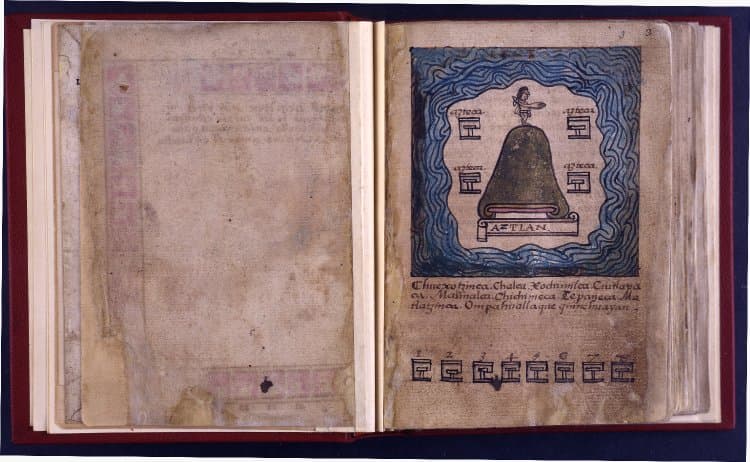
Folio 3 – Folio 3 represents the beginning of the people’s migration history. This mythical image shows a version of Aztlán, the sacred place that the Mexicas considered their origin. It depicts a figure standing atop a hill on an island. The figure is Huitzilopochtli, the patron god of the Mexicas. The four glyphs surrounding the figure represent houses, symbolizing the four calpullis coming from an island. The eight house glyphs below the island represent the other eight calpullis accompanying the original four lineages during the migration.
Folios 4-22 – The following folios contain a few pictographic descriptions of the places the Mexicas traveled during migration. The folios mainly contain a year count showing how long the Mexicas migrated before reaching the place that would become Tenochtitlán.
Folio 14 – As an example of the Mexica migration route, folio 14 explains that the Mexica spent a period of 20 years in Cohuatitlan. It uses the head of a snake to represent Cohuatitlan, better known in Mexica mythology as the place of snakes. The document then explains that the Mexicas moved to Huixachtitlan, where they lived for 4 years. The use of a tree with thorny roots represents “Huixachtitlan,” a Nahuatl word meaning “place of thorns or acacias.”
The Foundation of Tenochtitlán
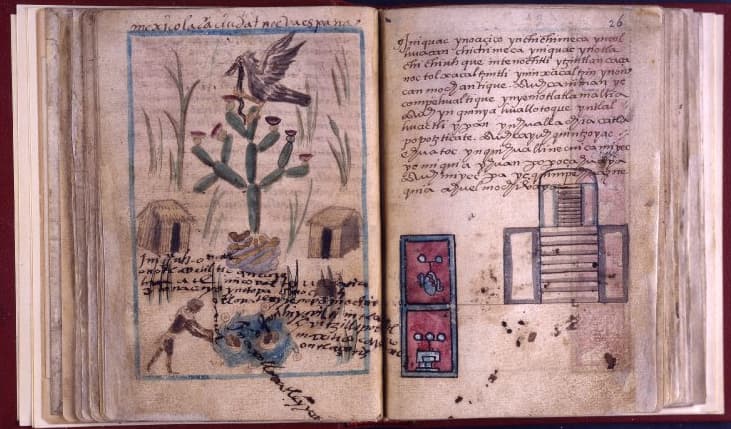
Folios 23-25 – This image shows the conclusion of the Mexica migration with the foundation of Tenochtitlán. It illustrates a swampy place where an eagle, perched on a cactus, has caught a snake. This is the traditional representation of Tenochtitlán. It also illustrates the simple principles of the city, as the artist painted a straw hut on each side of the page with various herbs in the background. The text on the next page explains that the Mexica figure is a fisherman. Various historians note that the Aubin Codex is one of the few codices that includes this image in the same way it will later appear in Mexico’s national emblem.
There is a significant format change here. From this folio onwards, the calendar squares are organized in vertical rows. The new-year count starts next to the temple image. This pattern continues throughout the rest of the codex.
The First Dynastic Section
Folios 26-42 – The Aubin Codex, like many other Aztec stories, includes a dynastic section listing the ascensions and deaths of notable rulers of Tenochtitlan. Starting on folio 26, the dynastic section contains pages indicating the year and rulers. These pages lack images and events. Instead, each page covers five years, counted vertically on the left side.
Folio 30 – As an example of the dynastic section, folio 30 shows the ascent of Huitzilíhuitl to the Mexica throne. Huitzilíhuitl ruled from the year 1 Reed to 5 Serpent, according to the codex, corresponding to the years 1395-1417 in the Gregorian calendar. The page on the right shows the passage of the fifth 52-year cycle, symbolized by an image of a grasshopper. This is one of the few times a natural or agricultural event is observed in the Aubin Codex. Some scholars speculate that the grasshopper was somehow linked to the New Fire ceremony that the Mexicas celebrated to commemorate a new 52-year cycle. Others speculate that during this year, there was a famine due to crop damage caused by grasshoppers.
Folio 35 – After a flood, some Mexica families were forced to sell their children as slaves. This folio shows two slaves tied together on their way to be sold. The flood was named “1 Rabbit.”
The Spanish Conquest
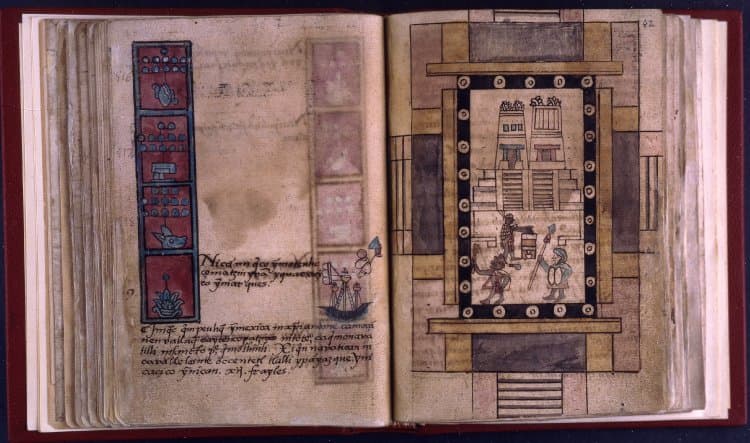
Folio 42 – The left page illustrates the arrival of the Spanish by boat. Also, this folio declares the death of Moctezuma on the date of Ce Acatl, 1519. A cross on the mast of this image is highlighted. Though not very large, it is an element seen in many images of the Spanish conquest. It is also a symbol representing the arrival of Jesus Christ and Christianity in the New World. Often, the arrival of the Spanish and the death of Moctezuma are depicted together because they symbolize the end of the Mexica empire’s rule and the beginning of the Spanish empire’s history in America.
Therefore, the right page shows a battle scene between a Spanish conquistador and an Aztec soldier. The Spanish conquistador is identified by his armor, spear, and beard. The Aztec can also be identified by his attire. They are fighting in the Templo Mayor, as indicated by its double temples. The Templo Mayor was “the ritual and political heart” of the city of Tenochtitlán. There, according to several Spanish and indigenous chroniclers, including the notable book “Visión de los vencidos,” the conquistador Pedro de Alvarado, also known as “El Sol,” initiated the massacre against “unarmed warriors, priest-musicians, women, children, and the elderly.”
Furthermore, these two pages are significant because they represent the end of the calendrical strip and that “the massacre of the Templo Mayor has stopped time.” The Spanish conquest is depicted on a whole page, a division that reflects its great importance in Mexica history.
History After the Spanish
Folios 43-69 – These pages describe the history of the Mexica after the conquest and return to a style similar to folios 26-42: dense text with few images. They mainly use written text to explain the Spanish conquest and the violence that occurred. Folio 43 details the battle at the Templo Mayor, which was illustrated in folio 42. It is also seen that these folios are different due to the use of Latin characters. The formal elements of the text graphically or visually represent the central theme of the historical moment: that is, the end of the Mexica era and the beginning of the Christian era. However, while narrative writing is associated with Christian culture, the images are associated with Mexica culture.
Folio 59 – Towards the end of the codex, the model of five years per page changes, as here, one year is shown per page. The chronological framework is represented by the singular red square, presented here as a rectangular block. Scholars speculate that the years after the conquest were filled with profound changes in the cultural, political, and economic structures of the Mexica. Therefore, scribes thought it necessary to explain these transformations in more detail with a different visual presentation.
At the top of folio 59, there is news that the list of offenses against the Christian faith that would be punished by the Tribunal of the Holy Office of the Inquisition, instituted in 1571, was publicly circulated. The gloss mentions Pedro Moya de Contreras as the inquisitor. The following paragraph is accompanied by an image of Jesus Christ, seated beside a cross. The Virgin Mary and Mary Magdalene are the two women beside him. The gloss explains that the image represents a Good Friday procession. The tlacuilo set aside his traditional way of painting, planiform and conceptual, to imitate European models that were more perceptual and three-dimensional. This is the only case of this graphic expression in the codex.
The Second Dynastic Section
Folios 70-81 – There is a smaller list of dynastic succession after the final recount in the year 1607. This section was likely illustrated by a different artist. Each page in this section represents a ruler, accompanied by the number of years they reigned, communicated through various blue circles. The list of kings continues beyond the Mexicas and includes Spaniards and conquerors.
Folio 77 – As an example of the second dynastic section, folio 77 shows the election of Diego de Alvarado Huanitzin as ruler. Huanitzin was the grandson of Emperor Axayácatl and the nephew of Moctezuma. The four turquoise discs in front of him represent his four years of reign. He is seated on the tepotzoicpalli, a throne with a high back for kings.
Style and Aesthetics
The Aubin Codex is a mixed codex, meaning a work that combines images and written text in the Nahuatl language. The codex has images in red, brown, turquoise, gray, and black. It is characterized by the paintings of the tlacuilos, translated from Nahuatl to Spanish as “the one who writes by painting.” To the left of most pages, there are red and blue boxes indicating the year in the Mexica calendar. Additionally, there are Latin numbers near many images. The other images and words in Nahuatl describe the events that occurred during these marked years.
Spanish Influence on the Aubin Codex
The Aubin Codex manifests the characteristics of the tlacuilos and, at the same time, the text indicates some influence from European trends and styles of the 16th century. In this way, the Aubin Codex is considered a good example of the format change in pre-Columbian writing after the Spanish conquest of America.
In pre-Columbian times, the Nahuatl language was primarily a spoken language, rather than an alphabetical one, and stories were largely pictorial. In comparison, the Aubin Codex is concise in the pictorial part, emphasizing the role of Nahuatl text, now written in Latin letters, in explaining the main history. These notable changes indicate the increasing importance of the written language and the spread of European methods among indigenous peoples. The Aubin Codex also stands out from other pre-Columbian manuscripts because it follows the European standard of bound pages.
This shows a significant modification of traditional Mesoamerican narration. The textual format perfected by indigenous peoples allowed pages to unfold to display the entire story at once, making it easier to read and visualize the stories. Additionally, storytelling was traditionally a performative and social act, with various speakers recounting stories to an audience or a specific public. The speaker would be able to translate the pictograms in an oral and performative manner.
However, written Nahuatl, influenced by the Spanish, creates a more solitary relationship with narration and the codex. There were no images to show to a group of listeners. Therefore, due to Spanish influence, the Aubin Codex lacks the traditional performative characteristics of indigenous stories in America. It is considered an excellent example of the hybrid literature of the colonial era, integrating various graphic and narrative elements from the New World with European models.
The Relationship of the Aubin Codex with the Codex Boturini
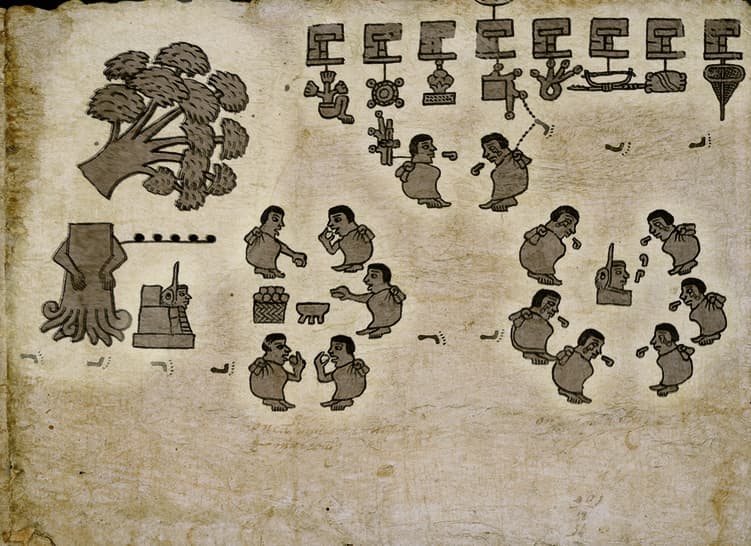
There is evidence that describes sections of the Aubin Codex as a summary of the Pilgrimage Strip. The Pilgrimage Strip, also known as the Boturini Codex, is another Mexica codex. The pilgrimage of the Mexicas “begins with the representation of the legendary Aztlán, until the arrival at Chapultepec, a transcendental site in the Valley of Mexico where the spring was located that would later supply water to the entire city of Tenochtitlán.”
The Aubin Codex was probably written shortly after the Pilgrimage Strip and shows changes that the pictographs underwent during the colonial period. At many points, due to Spanish influence, pictographic reading was replaced by alphabetic reading. There was no longer a need to explain in pictographs what could be explained in written characters.
Folio 5 of the Aubin Codex
On folio 5 of the Aubin Codex, only the tree with the deity’s bundle at its feet is visible, and next to it, there appear to be four Aztecs eating. This is known from the pictorial parallel, folio 3 of the Strip. The Aubin Codex does not show the rest of the group or the peoples accompanying them in the Strip. It results in “a much more careless and schematic drawing, whose function seems to be limited to illustrating a long text, or perhaps to entertain it.”
The footprints on the ground, in folio 3 of the strip, represent the path to be followed to understand the strip chronologically. It leads first to a broken tree, and at its feet is the temple of Huitzilopochtli in its hummingbird incarnation. There, the footprints are interrupted, and the Aztecs sit down to eat. The text of the Aubin Codex says:
“And when they came to the foot of a tree, there they sat down. The tree was very thick. Then they formed an altar there, on which they placed the devil. When they had formed the altar, then they took their provisions. But since they were going to eat, then the tree broke over them.”
The footprints continue and lead us to the same Aztecs, but today they cry and speak in front of the god. However, it seems that only one communicates directly with the god. It can be seen through their “tears” touching the god. The text of the Aubin Codex explains what happens:
“Then, because of this, they left what they were eating, for a long time they remained with bowed heads. And then, the devil called them, and said to them: Send to the eight calpulli that accompany you, tell them: we will not go ahead, we will go in another direction.”
The eight calpullis represent the eight villages that the Aztecs encountered in Teoculhuacan, shortly after leaving their original homeland, Aztlan. In the illustration above, the Aztec leader communicates with the lord of Cuitlahuac and begins to cry. The text of the Aubin explains:
“When they had been told this, those eight calpulli became very sad. When they had been ordered, the eight calpulli said: Our lords, where will we go? For we will accompany you. Then they told them again: Do not go. Then first the eight calpulli left. There they left them at the foot of the tree; they remained there for a long time.”
Folio 6 of the Aubin Codex
These figures, in total or summary, are a representation of the ritual involving thorny plants.
On folio 4 of the strip, the footprints lead the chronology of the pictography again. There is also less detail and glyphs in the Aubin Codex again. In the strip, initially, the departure of two different footprints is seen. This indicates the departure of the group from the previous figure.
The Aubin Codex tells us:
“Afterwards, when they set out on the road, the owl men came to fall upon them. Among the cacti, they kept falling, and some kept falling at the foot of the mesquite trees. These were called mimixcoa: the first was named Xiuhneltzin, the second was named Mimichtzin, and the third, was a woman, their older sister. Again there the devil Huitzilopochtli called them; he said: Take those among the cacti. They will be the first tribute.”
Compared to the Strip, the size of the cacti in the Aubin Codex is greatly reduced, and they are placed closer together than in the strip. The mesquite loses its thorny outer aspects and appears as a simple tree painted following pre-Hispanic canons.
In the Aubin Codex, none of the sacrificed individuals have a nominal glyph above their heads, and there is no one else besides the sacrificed. The drawing is so altered that the mesquite is placed on top of one of the sacrificed rather than the other way around.
Folio 8 of the Aubin Codex
This is the arrival and stay in Tula of the Mexicas.
The Aubin Codex has pages like this, of reduced size (11 x 15 cm), for each of the places where the group stayed. Rectangular chronicles, representing the years spent in each place, are grouped on it. In the upper left, the arrival year is indicated. Next to it, there is a gloss representing the date they arrived at the designated site. This glyph is drawn at the bottom of the page. Another gloss refers to the group’s arrival at that place, as well as the years of stay.
In the Strip, the groups of chronological rectangles are read from bottom to top, vice versa, and from left to right. But in the Aubin Codex, it is read from left to right and from top to bottom. Also, in the Strip, it is very clear that the departure from one place and the arrival at another occurs on the same date, but it is not as clear in the Aubin Codex. The scribe of the Aubin Codex only marked the year of departure on the page reserved for the new arrival place.
Featured Image: codex; manuscript | British Museum


